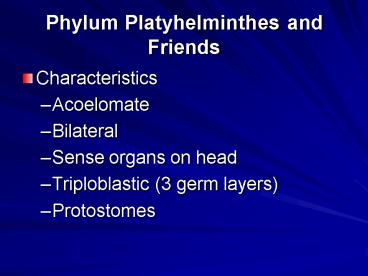Phylum Platyhelminthes and Friends - PowerPoint PPT Presentation
1 / 36
Title:
Phylum Platyhelminthes and Friends
Description:
Some free-living; some parasitic (may have several hosts) 4 Classes. Turbellaria. Trematoda ... Most free-living, carnivorous. 5 mm to 50 cm. Locomotion ... – PowerPoint PPT presentation
Number of Views:695
Avg rating:3.0/5.0
Title: Phylum Platyhelminthes and Friends
1
Phylum Platyhelminthes and Friends
- Characteristics
- Acoelomate
- Bilateral
- Sense organs on head
- Triploblastic (3 germ layers)
- Protostomes
2
Platyhelminthes
- Characteristics
- Mesodermal parenchyma
- 1 mm to many meters
- Some free-living some parasitic (may have
several hosts)
3
4 Classes
- Turbellaria
- Trematoda
- Monogenea
- Cestoda
4
Form and Function
- Turbellarians
- Ciliated epidermal cells (some syncytial)
- Basement membrane
- Muscle fibers
- Rhabdites
- Dual-gland adhesive organs
- Parenchyma
5
Form and Function, cont.
- Non-turbellarians (Neodermata)
- No cilia
- Tegument
6
Nutrition/Digestion
- Cestodes
- No digestive system
- Adsorb nutrients from host
7
Nutrition/Digestion, cont.
- Othersmouth, pharynx, intestine
- Planaria
- Carnivores
- Rhabdites secrete mucous
- Extends proboscis
- Monogeneans Trematodes
- Feed on host cells, debris, body fluids
8
Excretion/Osmoregulation
- Protonephridia with flame cells
- Ions and molecules resorbed as needed
- Most metabolic wastes removed by diffusion
- Canal and bladder systems vary among classes
9
Nervous System
- Subepidermal nerve plexus (net) or
- Net plus nerve cords under muscle layer
- Neuron types
- Sensory
- Motor
- Association
10
Sense Organs
- Cephalization aids locomotion
- Ocelli (eyespots)
- Tactile cells
- Chemoreceptive cells
- Statocysts in some
- Rheoreceptors (water currents)
11
Reproduction/Regeneration
- Fission
- Sexual reproduction
- Most monoecious
- Cross-fertilize
- Most egg yolk produced by vitellaria
- Eggs (with yolk) attached to plants
- Most direct metamorphosis
- Parasitic larvae ciliated or hatch after being
eaten
12
Class Turbellaria
- Most free-living, carnivorous
- 5 mm to 50 cm
- Locomotion
- Ciliated epithelium
- Rhabdites (slime track)
- Regeneration
- Polarity retained
13
2 Orders
- Orders determined based on form of gut and
pharynx - Tricladida
- Simple (3 branches) or no gut
- Simple pharynx when present
- Polycladida
- Highly branched gut
- Folded pharynx
14
Class Trematoda
- Parasitic flukes
- Most endoparasites of vertebrates
- Adaptations
- Penetration glands
- Produce cysts
- Suckers
- Increased reproductive capacity
- Poorly developed sense organs
15
Subclass Digenea
- Mollusc (first intermediate host)
- Vertebrate (definitive host)
- Serious parasites of humans and domestic animals
- Examples
- Liver fluke
- Blood fluke
- Lung fluke
16
Sheep Liver Fluke
- Fasciola hepatica
- Life cycle
- Eggs
- Miracidia hatch, penetrate snails
- Sporocysts
- Rediae
- Cercaria encyst on vegetation
- Sheep eat
- Young fluke
17
Human Liver Fluke
- Clonorchis sinensis
- China, Japan, Southeast Asia
- Also infects cats, dogs, pigs
- 10-20 mm
18
Clonorchis Life Cycle
- Eggs to miracidia to snails to sporocysts to
rediae to cercaria to bore and encyst in fish
(Cyprinidae) - Mammals eat raw fish, young flukes to liver
19
Clonorchis Life Cycle
20
Blood Flukes
- Schistosoma
- 200 million people infected
- Africa, South America, West Indies, Middle and
Far East - Dioecious
- Schistosome dermatitis
- Swimmers itch
21
Schistosoma Life Cycle
22
Lung Flukes
- Paragonimus westermani
- Humans, pigs, rodents
- Life cycle
- Eggs coughed up, swallowed, eliminated in feces
- Miricidia to snail to sporocysts to rediae to
cercariae - Freshwater crabs eat
- Humans eat raw
23
Class Monogenea
- Most external parasites of fish
- Some in bladders of frogs, turtles
- Posterior attachment organ with hooks, suckers,
clamps (opisthaptor) - Monoecious
24
Monogenean Life Cycle
- Egg
- Ciliated larva (oncomiracidium) with posterior
hooks - Attaches to host
25
Class Cestoda
- Tapeworms
- Segmented shape (proglottids)
- Monoecious
- Scolex (head portion with suckers, hooks
- 2 hosts adult parasitic in vertebrate digestive
tract
26
Subclass Eucestoda
- Chain of proglottids (strobila) arises from
germinative zone - 1000 species, including
- Beef tapeworm
- Pork tapeworm
- Fish tapeworm
- Unolocular hydatid
27
Beef Tapeworm
- Taenia saginata
- Adult in alimentary canal of humans
- Juvenile in cattle tissue
- 10 m long, 2000 proglottids
- Life cycle
- Proglottid passes, cattle eat shelled larvae,
muscle cysts, humans eat rare beef, intestinal
cysticercus
28
Taenia Life Cycle
29
Pork Tapeworm
- Taenia solium
- Adult in small intestine of humans
- Juvenile in pig muscles
- Scolex with suckers and hooks on rostellum
- Cysticerci in organs
- In eyes or brainblindness, death
30
Fish Tapeworm
- Diphyllobothrium latum
- Adult in intestines of humans, dogs, cats, etc.
- Juvenile in crustaceans, fish
- 20 m
- Humans eat raw fish
31
Unilocular Hydatid
- Echinococcus granulosus
- Adult in canines
- Juvenile in mammals
- Intermediate hosthuman
- Juvenile hydatid cyst (grows up to 20 years)
32
Phylum Nemertea
- Ribbon worms (most less than 20 cm)
- Characteristics
- 650 species
- Simplest animal with blood-vascular system (but
no heart) and one-way alimentary canal - Eversible proboscis grasps prey
- Most marine, free-living
33
Nemertean characteristics, cont.
- Most dioecious
- Ciliated epidermis
- Carnivorous
- Respiration through body surface
- Brain, sense organs, longitudinal nerves
- Tail can regenerate new proboscis
34
Phylum Gnathostomulida
- Jaw worms (1 mm)
- Characteristics
- 80 species
- Commonly found in sediment
- No pseudocoel, circulatory system, or anus
- Ciliated epidermis
- Males, females, or hermaphrodites
- Some features similar to rotifers
35
Phylogeny
- From theorized planuloid ancestor
- Sessile, radial branch (cnidarians)
- Creeping, bilateral branch (flatworms)
- Cephalization
- Turbellarians
- Ciliated epithelium, mucous glands
- Trematodes, monogeneans, cestodes
- Nonciliated, syncytial tegument, muscle
36
Adaptive Radiation
- Parasitic body shape, metabolism
- Ribbon worms evolved for predatory niche
- Jaw worms evolved for low oxygen, marine
environments































